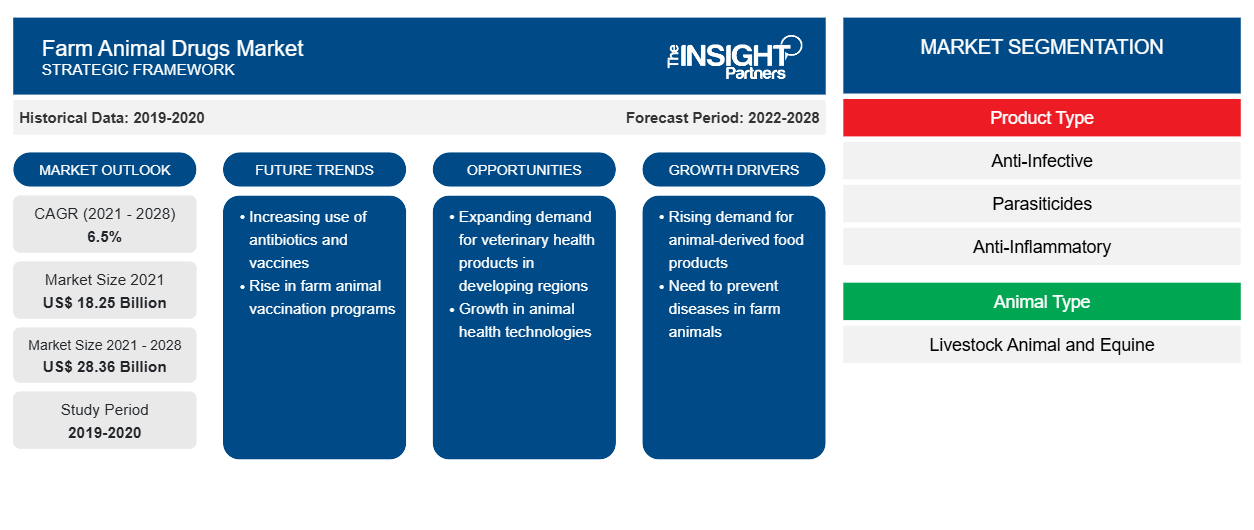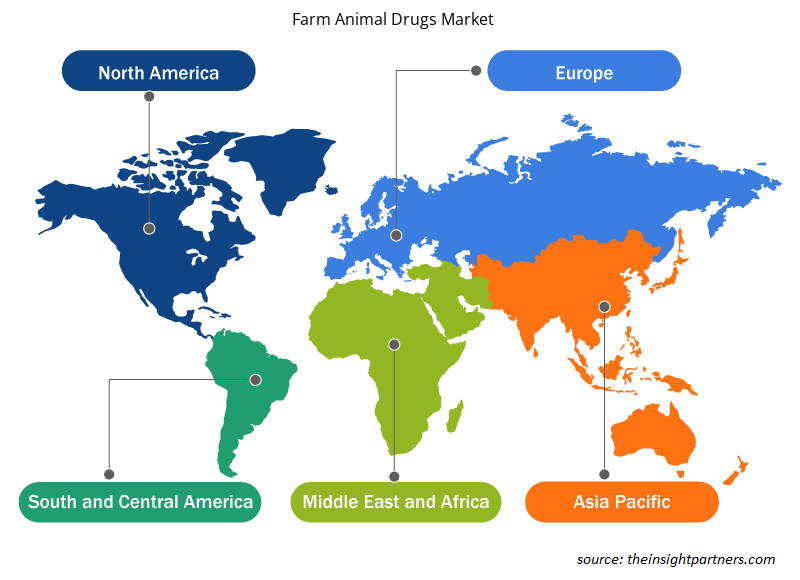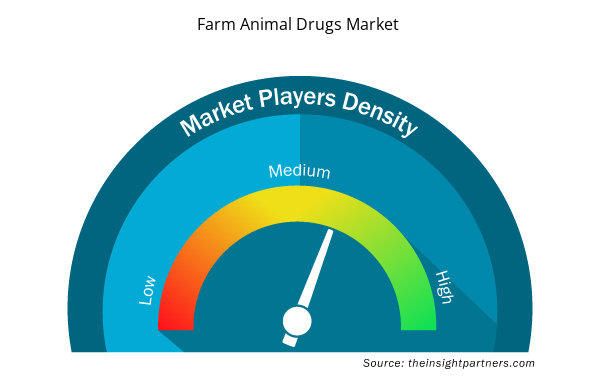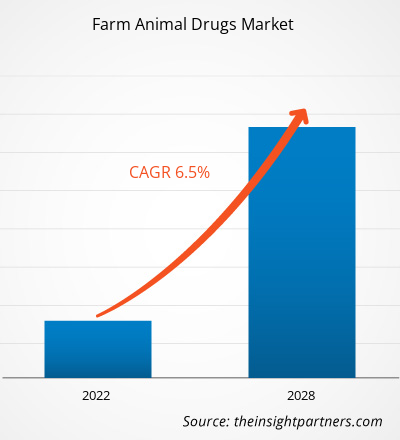The farm animal drugs market is projected to grow from US$ 18,253.09 million in 2021 to US$ 28,364.08 million by 2028; it is estimated to grow at a CAGR of 6.5% from 2021 to 2028.
Drugs play a key role in maintaining the health of farm animals and improving the economic condition of farm producers. The need for better productivity has become important more, as the population are looking for nutritious and disease-free food products. The pharmacologically active compounds help prevent the passing of diseases from animals to humans. Farm animal’s health have been considerably shaped by the use of drugs. Farm animal drugs are medicines used for healthcare-based practices for diagnosis, cure, mitigation, treatment, or prevention of diseases that could affect livestock. These medicines are used as per strict requirements based on their essentiality to maintain the well-being of farm animals. Simply said, farm animal drugs are a key factor supporting the growth of the livestock industry across the world. Factors such as the growing use of pain management drugs in farm animals, rising incidence of foodborne diseases and infections, and surging demand for quality pharmaceuticals and food security boost the growth of the farm animal drugs market. However, the side effects of drugs in animals and strict government rules related to the usage of farm animal drugs hamper the growth of the market.
Customize This Report To Suit Your Requirement
You will get customization on any report - free of charge - including parts of this report, or country-level analysis, Excel Data pack, as well as avail great offers and discounts for start-ups & universities
Farm Animal Drugs Market: Strategic Insights

- Get Top Key Market Trends of this report.This FREE sample will include data analysis, ranging from market trends to estimates and forecasts.
You will get customization on any report - free of charge - including parts of this report, or country-level analysis, Excel Data pack, as well as avail great offers and discounts for start-ups & universities
Farm Animal Drugs Market: Strategic Insights

- Get Top Key Market Trends of this report.This FREE sample will include data analysis, ranging from market trends to estimates and forecasts.
Market Insights
Growing Use of Pain Management Drugs in Farm Animals Bolsters Farm Animal Drugs Market Growth
Pain in farm animals is often associated with common production diseases, such as lameness and mastitis, and is brought to the animal through routine husbandry practices, such as castration and tail docking. Pain causes behavioral, autonomic, and neuroendocrine changes; and induces a negative affective state, compromises animal welfare, and harms the profitability of agriculture.
Controlling pain is essential to the health of all animals. In 2018, the Food and Drug Administration (FDA) approved the first pain reliever for use in a food-producing animal. Foot rot is a common cause of pain and lameness in cattle of all ages and breeds. The disease is seen in cattle kept in barns and pylons, as well as cattle on pasture. Banamine Transdermal is approved to treat the pain associated with foot rot in cattle, and it can only be obtained with a prescription. The FDA Center for Veterinary Medicine promotes and protects animal health by ensuring safe and effective medicines are available to animals. Working with pharmaceutical companies to develop and approve drugs to control pain in all animals, including food-producing animals, is an integral part of this mission.
There are several routine practices in animal husbandry that demand efficient pain management in animals. Some routine procedures that cause pain in farm animals include castration, dehorning or disbudding. and branding. The most common drugs used for pain control in farm animals include nonsteroidal anti-inflammatory drugs (NSAIDs), local anesthetics, α2-agonists and opioids. Efficient management of pain in food-producing animals has gradually become a matter of consumer concern worldwide, and this has therefore resulted in high interest of regulatory authorities. Consequently, the animal husbandry industry worldwide is evolving with new practices and use of off-label analgesics with keeping animal welfare and profitability in consideration. This has therefore led to significant rise in analgesic drugs such as lidocaine, xylazine, detomidine, medetomidine, ketamine, tolfenamic acid, buprenephrine, etc. in general pain management practice for farm animals.
Consumers are becoming increasingly aware and concerned about the welfare of animals raised for food. This has put pressure on suppliers to ensure that animals entering their systems are treated humanely. Measures are being taken for addressing such demand. Only one drug is approved in the US to control interdigital phlegmon (foot rot) pain in non-lactating cattle. Therefore, using medications for pain management in elective procedures, such as dehorning and castration, in cattle or analgesia in lactating dairy cows and pigs is considered an extra-label drug use. It is regulated as per the clarification on the use of veterinary drugs law. Flunixin, meloxicam, and ketoprofen are nonsteroidal anti-inflammatory drugs with supportive research on on-farm analgesia. Several products, such as local and regional anesthetics, opioids, and nonsteroidal anti-inflammatory drugs (NSAIDs), are available in the market to relieve pain in animals.
Product Type-Based Insights
Based on product type, the farm animal drugs market is segmented into anti-infective, parasiticides, anti-inflammatory, anesthetics, analgesics, hormones and related product, and others. The parasiticides segment held the largest market share in 2021 and is expected to register the highest CAGR during the forecast period.
Animal Type-Based Insights
Based on animal type, the farm animal drugs market is bifurcated into livestock animals and equine. The livestock animals segment held the largest market share of 90.77% in 2021, and is expected to retain its dominance during the forecast period.
Route of Administration-Based Insights
Based on route of administration, the farm animal drugs market is segmented into oral, parenteral, topical, and others. The oral segment held the largest market share of 90.77% in 2021, and is expected to retain its dominance during the forecast period.
Distribution Channel-Based Insights
Based on distribution channel, the farm animal drugs market is segmented into veterinary hospitals, veterinary clinics, pharmacies and drug stores, and others. The veterinary hospitals segment held the largest market share in 2021, whereas the market for the veterinary clinics segment is expected to grow at a CAGR of 6.9% during the forecast period.
Various companies operating in the farm animal drugs market are adopting strategies such as product launches, mergers and acquisitions, collaborations, product innovations, and product portfolio expansions to expand their footprint worldwide, maintain brand name, and meet the growing demand from end users.
Farm Animal Drugs Market Regional Insights
The regional trends and factors influencing the Farm Animal Drugs Market throughout the forecast period have been thoroughly explained by the analysts at Insight Partners. This section also discusses Farm Animal Drugs Market segments and geography across North America, Europe, Asia Pacific, Middle East and Africa, and South and Central America.

- Get the Regional Specific Data for Farm Animal Drugs Market
Farm Animal Drugs Market Report Scope
| Report Attribute | Details |
|---|---|
| Market size in 2021 | US$ 18.25 Billion |
| Market Size by 2028 | US$ 28.36 Billion |
| Global CAGR (2021 - 2028) | 6.5% |
| Historical Data | 2019-2020 |
| Forecast period | 2022-2028 |
| Segments Covered |
By Product Type
|
| Regions and Countries Covered | North America
|
| Market leaders and key company profiles |
Farm Animal Drugs Market Players Density: Understanding Its Impact on Business Dynamics
The Farm Animal Drugs Market is growing rapidly, driven by increasing end-user demand due to factors such as evolving consumer preferences, technological advancements, and greater awareness of the product's benefits. As demand rises, businesses are expanding their offerings, innovating to meet consumer needs, and capitalizing on emerging trends, which further fuels market growth.
Market players density refers to the distribution of firms or companies operating within a particular market or industry. It indicates how many competitors (market players) are present in a given market space relative to its size or total market value.
Major Companies operating in the Farm Animal Drugs Market are:
- PHIBRO ANIMAL HEALTH CORPORATION
- Zoetis Inc.
- Ceva
- Elanco
- Virbac
Disclaimer: The companies listed above are not ranked in any particular order.

- Get the Farm Animal Drugs Market top key players overview
Farm Animal Drugs Market – by Product Type
- Anti-Infective
- Parasiticides
- Anti-Inflammatory
- Anesthetics
- Analgesics
- Hormones and Related Product
- Others
Farm Animal Drugs Market – by Animal Type
- Livestock Animal
- Equine
Farm Animal Drugs Market – by Route of Administration
- Oral
- Parenteral
- Topical
- Others
Farm Animal Drugs Market – by Distribution Channel
- Veterinary Hospitals
- Veterinary Clinics
- Pharmacies and Drug Stores
- Others
Farm Animal Drugs Market – by Geography
• North America
- US
- Canada
- Mexico
• Europe
- France
- Germany
- Italy
- UK
- Spain
- Rest of Europe
• Asia Pacific (APAC)
- China
- India
- South Korea
- Japan
- Australia
- Rest of Asia Pacific
• Middle East & Africa (MEA)
- South Africa
- Saudi Arabia
- UAE
- Rest of Middle East & Africa
• South & Central America (SCAM)
- Brazil
- Argentina
- Rest of South and Central America
Company Profiles
- PHIBRO ANIMAL HEALTH CORPORATION
- Zoetis Inc.
- Ceva
- Elanco
- Virbac
- INTAS PHARMACEUTICALS LTD.
- Alembic Pharmaceuticals Limited
- Boehringer Ingelheim International GmbH
- MSD Animal Health
- Vetoquinol SA
- Historical Analysis (2 Years), Base Year, Forecast (7 Years) with CAGR
- PEST and SWOT Analysis
- Market Size Value / Volume - Global, Regional, Country
- Industry and Competitive Landscape
- Excel Dataset



Report Coverage
Revenue forecast, Company Analysis, Industry landscape, Growth factors, and Trends

Segment Covered
Product Type, Animal Type, Route of Administration, and Distribution Channel, and Geography

Regional Scope
North America, Europe, Asia Pacific, Middle East & Africa, South & Central America

Country Scope
Argentina, Australia, Brazil, Canada, China, France, Germany, India, Italy, Japan, Mexico, RoAPAC, RoE, RoMEA, RoSCAM, Saudi Arabia, South Africa, South Korea, Spain, United Arab Emirates, United Kingdom, United States
Frequently Asked Questions
Which route of administration held the largest share in the farm animal drugs market?
The oral segment dominated the global farm animal drugs market and accounted for the largest revenue share of 42.81% in 2021.
Which distribution channel held the largest share in the farm animal drugs market?
The veterinary hospitals segment dominated the global farm animal drugs market and accounted for the largest revenue share of 36.70% in 2021.
Who are the key players in the farm animal drugs market?
The farm animal drugs market majorly consists of the players such PHIBRO ANIMAL HEALTH CORPORATION, Zoetis Inc., Ceva, Elanco, Virbac, INTAS PHARMACEUTICALS LTD., Alembic Pharmaceuticals Limited, Boehringer Ingelheim International GmbH, MSD Animal Health, and Vetoquinol SA among others.
Which product type led the farm animal drugs market?
The parasiticides segment dominated the global farm animal drugs market and held the largest revenue share of 26.88% in 2021.
Which animal type held the largest share in the farm animal drugs market?
The livestock animals segment dominated the global farm animal drugs market and accounted for the largest revenue share of 90.77% in 2021
What are the driving factors for the farm animal drugs market across the globe?
Key factors that are driving the growth of this market are the growing use of pain management drugs in farm animals, rising incidence of foodborne diseases and infections, and surging demand for quality pharmaceuticals and food security are expected to boost the market growth for the farm animal drugs over the years.
What is farm animal drug?
Drugs play a key role in maintaining the health of farm animals and improving the economic condition of farm producers. The need for better productivity has become important more, as the population are looking for nutritious and disease-free food products. The pharmacologically active compounds help prevent the passing of diseases from animals to humans. Farm animal’s health have been considerably shaped by the use of drugs. Farm animal drugs are medicines used for healthcare-based practices for diagnosis, cure, mitigation, treatment, or prevention of diseases that could affect livestock. These medicines are used as per strict requirements based on their essentiality to maintain the well-being of farm animals. Simply said, farm animal drugs are a key factor supporting the growth of the livestock industry across the world.
Trends and growth analysis reports related to Life Sciences : READ MORE..
The List of Companies - Farm Animal Drugs Market
- PHIBRO ANIMAL HEALTH CORPORATION
- Zoetis Inc.
- Ceva
- Elanco
- Virbac
- INTAS PHARMACEUTICALS LTD.
- Alembic Pharmaceuticals Limited
- Boehringer Ingelheim International GmbH
- MSD Animal Health
- Vetoquinol SA

 Get Free Sample For
Get Free Sample For